Ceremonies 1954-1969

Burgomaster Albert De Kesel, the king's representative, commodore Robijns,
Mr Paul Migeon and Minister Spinoy at the remembrance ceremony of 8 September 1957.
From 1954 until 1969 the pattern for the ceremony remained practically unchanged except for a few exceptional years. The same VIPs were always invited (the king's representative, the ambassador and members of the embassy, the East-Flanders governor, the bishop of Ghent, the representative of the Ministry of Defense, the burgomasters of the surrounding villages, top guns from the political and business world, military top brass) and again and again they gladly accepted the invitation.
There was always at least one band, often several. The greatest was the band of the Navy which in 1962 because of its presence at the remembrance ceremony year after year received a drum major baton from the Adegem town council. Mr. Duijck, the captain band master, was very happy with the gesture by the Adegem town council: "Allow me in this manner to express my personal gratitude for the exceptional way you have wished to express your appreciation and paid tribute to the music band of the Belgian Navy for the fact that for many years it has taken part in the annual homage to the dead in the Canadian cemetery of your town. This exceptional drum major baton will be a symbol of the appreciation and understanding between the military and the nation, here the town of Adegem."
On quite a number of years a Canadian band also accepted the invitation. Canada was always represented not only by its ambassador and other VIPs but also by Canadian military personnel who came over from France or who were stationed in Germany. For the town council it was quite a feat to find lodging for all these men but contacts with the Ministry of Defense generally were quite easygoing. Needless to say there was always a detachment of Belgian soldiers present: sometimes they were military men from the Eeklo Ammunitian Depot, on other years they were from the Sijsele Barracks and once they were the Belgian Navy men.
The guests were always welcomed at the church by Mr. Paul Migeon and the burgomaster of Adegem who had first put flowers on the graves of the Belgian soldiers and officers who had given their lives in Adegem during the 18 day campaign in 1940. Until 1963 the choir of the Notre Dame Church of Tielt took care of the solemn celebration of the Eucharist; from 1964 this duty was taken over by the choir of the deanery church of Saint Vincent. In 1962 the choir from Tielt surprised and moved the Canadians present with a Dutch version of the French-Canadian national anthem O Canada! which was followed by congratulations from the Canadians.
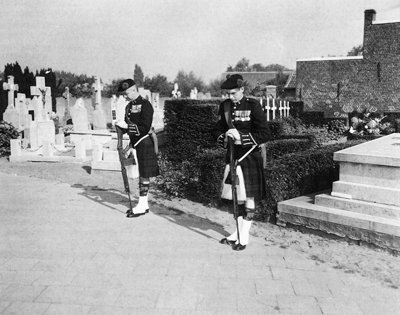
Every year before receiving the VIPs Paul Migeon and the burgomaster of Adegem
put flowers on the graves of Belgian victims of the 18-day campaign. Two
Canadian soldiers of the Queen's Own Rifles in typical mourning stature next
to the court of honor of the fallen Belgians.
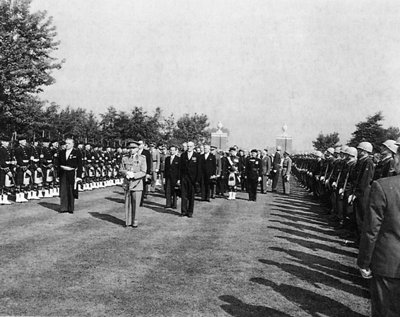
The guests arriving in the cemetery: burgomaster De Kesel,
representing the king, colonel-pilot Remy, Canadian ambassador Sydney Pierce
and Paul Migeon.
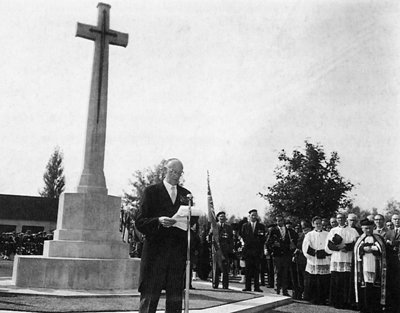
President Paul Migeon during his speech. In the background we recognize
vicar Omer Boudonck and parish priest Albert de Malsche. Behind the
Cross of Sacrifice we see the Navy Band.
About the traditional parade to the cemetery it was written without fail that it was huge and impressive. Almost always the band of the United Friends of Adegem opened the procession, followed by the children of the schools of Adegem, the patriotic associations, societies and organisations with their colourful flags and finally a great many individual pilgrims.
The ceremony in the cemetery always went the same way: speeches by Paul Migeon and the ambassador, a minute of silence during the Last Post, massive and impressive flower tributes. After closing with the national anthems everyone returned to the town hall for the reception and for signing the guest book. Each time after the ceremony the Belgium-Canada Association offered the guests a lunch in Ghent, Damme, Laarne or Bruges. During this lunch, usually with the Canadian ambassador and his wife in attendance informal contacts were made and friendschips renewed. The lunch was the high point of the day if we can believe the reports.
Now and again there was a slight departure from the usual pattern. For instance the ceremony of 9 September 1956 was closed by three miners with their lamps lighted, as as reminder of the terrible mining catastrophe in Marcinelle that cost the lives of 262 miners on 8 August 1956 and plunged the whole country in deep mourning.
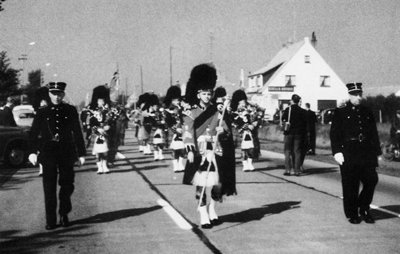
The First Battalion of the The Royal Black Watch (Royal Highlanders) of Canada
marches to the military cemetery accompanied by constables Albert Notteboom
and Richard Spillebeen (11 September 1960).
The World Exhibition of 1958 in Brussels also influenced things. In August there were the Canada days at the Exhibition in the presence of i.a. Mark Drouin, the president of the Canadian Senate. The ceremony in Adegem was moved to Sunday 24 August and was limited to the afternoon. The band of the Navy, the mariners, the Royal Canadian Air Force men and a kilted RCAF pipe band added lustre to the exceptional ceremony. A delegation of the Belgian division of the Canadian Veterans Association of the United Kingdom also took part in the procession. In the "Canadian Weekly Review" and "The Winnipeg Tribune" articles were published full of praise for the ceremony in Adagem (sic) under the titles Honor Canadian Dead in Adagem Ceremonies and Canadians Honor Belgium War Dead. They wrote that "each year since the end of the Second World War the Veterans and 5,500 people of this little agricultural town in the north-eastern Flemish section of Belgium make the pilgrimage honoring 913 Canadian soldiers buried here".
In 1959 Ambassador Sydney D. Pierce was present for the first time. He was received with great pomp on 17 July in Ghent where he went to see the port installations and several historic buildings. Of course on this occasion Mr. Paul Migeon was present for the first contacts and to invite the ambassador for the ceremony at Adegem on Sunday 13 September.
After it was all over, Ambassador Pierce didn't hide his praise for the ceremony: "I hasten to thank you and all members of the Association Belgique-Canada for the excellence of the arrangements of yesterday's ceremonies at Adegem." After the ceremony the band of the Navy treated the people of Adegem to a promenade concert in the town. The reception was perhaps a little less successful because the council chamber of the town hall was half empty: people wanted to see the musicians parading perfectly in step.
The performance of The Pipers Band of the Black Watch Royal Highlanders of Canada during the ceremony of 11 September 1960 was yet another great surprise. Marching through the town of Adegem, the detachment of bag pipes in full regalia was a very impressive sight.
In the cemetery itself everyone was dead quiet when major Magennis sounded the Retreat. After the ceremony The Pipers Band also paraded through the town. Without batting an eyelash, they marched past their ambassador who watched them from the town hall while hundreds of Adegemmers looked on. In the afternoon, the band gave a massively attended concert in Ghent.
On Sunday 10 September 1961 bag pipers were again in action and later on Captain W.R. Stewart wrote a very nice thank you letter: "We were most impressed with the sincerity of the Memorial Service. All my men left Adegem with the feeling that those Canadian soldiers resting in Belgian soil, shall always be fondly remembered by the Belgian people."
The year after, on Sunday 9 September 1962 the Canadian army sent the band of the 3rd Regiment of the Royal Canadian Horse Artillery. They really stood out in their splendid full dress uniforms. That evening these Canadian musicians gave a concert at the Ghent Annual Trade Fair and were applauded with great enthusiasm.
Also at the occasion of this ceremony the Adegem town council asked the provincial directorate, its hierarchical superiors, for once to also do something for the Canadian delegation. It doesn't happen very often that a town has to spur a provincial government into action. Here is how Adegem did it on 26 June 1963:
"For so many years now every second Sunday of September we remember the Canadian dead, the officers and soldiers who so far from home voluntarily made our freedom their goal in life. Wish the Provincial Government would for once also do something. After all it is for the liberation of the Province and the whole of Flanders that the Canadian and allied armies sacrificed so much.May we propose your Excellency examine the feasibility of inviting the Embassador and his retenue as well as the members of the Belgium-Canada Association. The Canadian Embassy and the citizens of Canada, a friendly nation that gave so much for our freedom, would find this very agreable indeed."
The call from Adegem was crowned with success because after the ceremony of 8 September 1963 all VIPs were invited by "The governor-President and the Members of the Permanent Deputation of the Provincial Council of East-Flanders to be their guest and to assist at the lunch which will take place after the Commemoration ceremony in the Canadian Cemetery at Adegem."
Prime Minister Theo Lefèvre honored the ceremony of 8 September with his presence together with the Minister of State August De Schrijver. During his speech in the town hall the prime Minister surprised all present with his announcement that President Paul Migeon was promoted by the king to Knight of the Leopold Order because of his many merits. When the news got out, congratulations came from everywhere. Congratulations also came from Canada and from none other than the Minister of Foreign Affairs himself; "I have been very happy to learn that you have been decorated with the order of Leopold by H.M. King Baldwin for your patriotism and zeal. I want to personally thank you for your ever so efficient contribution to the development of good relations between our two countries." ("J'ai donc été heureux d'apprendre que vous avez été décoré de l'ordre de Léopold par S. M. le roi Baudouin pour votre patriottisme et votre zèle. Je tiens personnellement à vous remercier pour votre contribution si efficace au développement des relations entre nos deux pays." )
On Sunday 13 September 1964 for the first time the formal service was taken care of by the choir of Eeklo's principal church under the direction of Edgard Steeghers with Nandor Neichel at the pipe organ. The bagpipes of the Black Watch were once again present. It is noteworthy that in this ceremony no one referred to the fact that this was the twentieth anniversary of the liberation of our region.
On the twentieth official commemoration ceremony of 12 September 1965, also the twentieth anniversary of the end of the war something very remarkable happened in the cemetery. After the floral tributes a plane of the Canadian Air Force flew very low over the cemetery and dropped thousands of poppies on the pilgrim and on the graves of the fallen.
"It was a very moving moment when the airplane of the Canadian Air Force flew over the cemetery at low altitude and dropped thousands of poppies" wrote 'La Flandre Libérale'. The rain of poppies as the Canadians called it became an annually returning part of the ceremony eagerly awaited by many children who tried to collect as many poppies as possible and this would eventually become somewhat perturbing.
The ceremony was special for yet another reason: the goodbye of Ambassador Pierce, who attended for the last time. "C'est avec un vif regret que je vous quitte", "I am very sorry to have to leave you", he wrote to his friend Paul Migeon and to burgomaster Albert De Kesel. "I am very sorry to leave my friends from Adegem and I thank you for all you and the people from Adegem have done for the relations between our two countries." And these were not empty words; ambassador Sydney Pierce didn't leave it at that: enclosed with his letter was a check "for the children of Adegem who have always contributed to the annual ceremonies with so much friendliness." A very surprised burgomaster De Kesel replied to the ambassador that he had handed over the amount of the check to the school boards and he thanked him for his friendly gesture.
Ambassador Paul Tremblay was there for the first time on 11 September 1966 and was specially delighted with the ceremony. "Ce sera un honneur pour moi d'assister à ces cérémonies annuelles", "It will be a great honor for me to be present at these annual ceremonies", he wrote to burgomaster De Kesel.
In 1967 the Canadian Federation feted its 100th anniversary and of course that influenced the annual Canada Day which exceptionally was organized in the afternoon of Sunday 10 September because the Canadian Embassy wanted to thank the people from Adegem with a great concert in the evening. In the town center a dais had been put up and the band "Fanfare de Magasin de Canada" with 50 musicians in colorful full dress uniform topped with a white spiked helmet played for more than an hour: marches but also Belgian, Flemish and Canadian folk songs. For instance "Tineke van Heule" was a great success. There was a whole lot of interest for this concert and 'Canada' was applauded very warmly also because every piece was introduced by an officer who spoke Dutch fluently.
Yet for a while it had looked like the day would not come off quite so perfectly because the Belgium-Canada Association was in a minor crisis: Jacques van Outryve d'Ydewalle was now wholly responsible for the organization of the ceremony because the president was ill. For the first time Mr Migeon was not present at the preparatory meeting at the Adegem town hall a few days before the ceremony and for the first time also Paul Migeon was not present on the day itself and ambassador Tremblay regretted it: "I am very sorry not to have seen you at Adegem this year", he wrote.
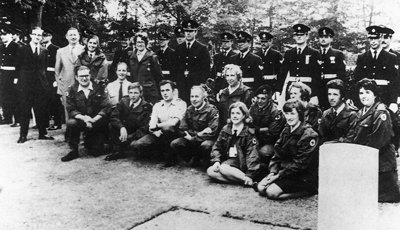
Every year the Maldegem Branch of the Belgian Red Cross was on hand for first
aid should a calamity strike. Especially when it was hot it happened that a
soldier would faint from the heat and need help. Here we see dr. Coelis Maurice, dr. Coelis Albert, Anette Nuyt, Rita
De Schepper, Willy De Cuyper, Monique Catrysse, Omer Van Caesele, Marc De Baets,
Raf De Baets, Mevrouw Catrysse, Daniel Van Praet, Carlos De Bree, Wilfried Ingels,
Dorine Eeckhout, Mady Eeckhout and Lieve Keirse.
The year 1967 was closed with a "centenary peal of the bells": the bells of Adegem tolled at the same time as those of St.-Paul in the Canadian province of Alberta. Later on the recording of the peal of the bells of Adegem was sent to St.-Paul.
Apparently the new schedule didn't quite please the Embassy because Tremblay pleaded for the return of a larger ceremony for 1968 and for keeping the 1967 time table.
On 8 September 1968 everything was again planned for the morning. As an exceptional guest Migeon who was back welcomed P.W. Segers, the Minister of Defense. It was to be the last time he would be able to do this.
In 1969 ceremonies were organized throughout the whole country because this was the 25th anniversary of the liberation of Belgium. Because of the ceremonies in Brussels on 14 September Embassador Tremblay proposed to have the annual Canada Day in Adegem a week earlier on Sunday 7 September. This posed no problem for the town council of Adegem but Migeon thought many groups and associations would be absent because for years and years they had always come to Adegem on the second Sunday of September and they might have other engagements for the first Sunday. The president was still struggling with health problems. He finally accepted the proposed arrangements.
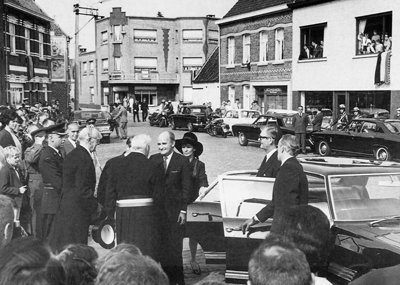
Burgomaster Albert De Kesel and President Paul Migeon welcomed the Canadian
Secretary of State Gerard Pelletier and his wife. The Secretary of State
had come over specially for the ceremony to add lustre to the 25th anniversary
of our liberation.
Colonel G. Janssens de Bisthoven, an acquaintance of Jacques van Outryve d'Ydewalle, would once again find out from the royal household if it wouldn't be possible for King Baldwin to assist at the ceremony. This appeared to be impossible since the king was already scheduled be present at three similar ceremonies and Adegem on top of that would be too much of a good thing for his Majesty. Migeon, undaunted, invited Prince Albert who had received a very warm welcome in Adegem at the ceremony for the 10th anniversary of the liberation.
"And I must tell you that the whole population of the region (very Royalist) wishes and hopes his Royal Highness Prince Albert will be able to come" he wrote in his letter of 8 July to the Field Marshal. Alas, Prince Albert was abroad on the day of the ceremony and sent word that he regretted very much being unable to assist at the ceremony.
The entire organization of this Canada Day was in the hands of the town council of Adegem. There was even a moment when an incident threatened after President Migeon had first asked burgomaster De Kesel and then van Outryve d'Ydewalle to speak in the cemetery. Both accepted but Jacques van Outryve d'Ydewalle left it to Burgomaster De Kesel.
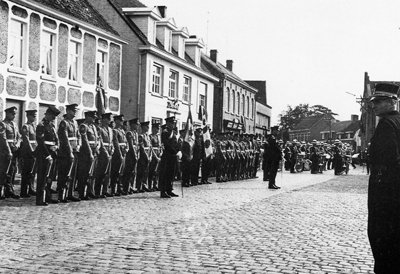
The
remembrance ceremony of 7 September 1969. The Canadian detachment,
impeccably in line awaiting the arrival of the VIPs. A little further
off we see the National Band of the Canadian Armed Forces who that evening
gave a concert in the center of Adegem as a thank you to the population of
Adegem and because of the 25th anniversary of the liberation.
In 1969 for the very first time a member of the Canadian government, to wit Secretary of State Gérard Pelletier would assist at the remembrance ceremony which once again took place in the afternoon. And also for the very first time it was Burgomaster Albert De Kesel who welcomed the personalities. Minister Pelletier was very happy with the ceremony and in his speech he spoke about the "sacrifice offered by our compatriots, most of them soldiers mowed down in their best years. They fought for respect and for human dignity, concluded the high official.
In the evening the population of Adegem was treated once again to a concert, this time by the National Band of the Canadian Armed Forces, whose 65 musician made music of the highest quality for the Adegemmers.
This Canada Day was the last for the Belgium-Canada Association because by the end of the year it was disbanded.
From now on the Adegem town council would all by itself organize the ceremony of remembrance.